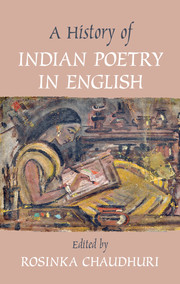Book contents
- Frontmatter
- Contents
- Contributors
- Acknowledgments
- Introduction
- SECTION I THE BROAD NINETEENTH CENTURY: INDIANS IN ENGLISH AND THE ENGLISH IN INDIA
- SECTION II PUBLISHERS, PUBLISHING HOUSES, AND THE PERIODICAL PRESS
- 9 “Zig Zag sublimity“: John Grant, the Tank School of Poetry, and the India Gazette (1822–1829)
- 10 “The Torch Not the Sceptre”: Writers Workshop, Calcutta
- 11 The Blue Rexine Archive: A Short History of Clearing House, a Poets’ Cooperative of the 1970s
- 12 “Melted Out of Circulation”: Little Magazines and Bombay Poetry in the 1960's and 1970's
- SECTION III POETRY: 1950–2000
- SECTION IV POETS OF THE DIASPORA
- SECTION V THE NEW MILLENNIUM POETS ON THEMSELVES
- Bibliography
- Index
11 - The Blue Rexine Archive: A Short History of Clearing House, a Poets’ Cooperative of the 1970s
from SECTION II - PUBLISHERS, PUBLISHING HOUSES, AND THE PERIODICAL PRESS
Published online by Cambridge University Press: 05 March 2016
- Frontmatter
- Contents
- Contributors
- Acknowledgments
- Introduction
- SECTION I THE BROAD NINETEENTH CENTURY: INDIANS IN ENGLISH AND THE ENGLISH IN INDIA
- SECTION II PUBLISHERS, PUBLISHING HOUSES, AND THE PERIODICAL PRESS
- 9 “Zig Zag sublimity“: John Grant, the Tank School of Poetry, and the India Gazette (1822–1829)
- 10 “The Torch Not the Sceptre”: Writers Workshop, Calcutta
- 11 The Blue Rexine Archive: A Short History of Clearing House, a Poets’ Cooperative of the 1970s
- 12 “Melted Out of Circulation”: Little Magazines and Bombay Poetry in the 1960's and 1970's
- SECTION III POETRY: 1950–2000
- SECTION IV POETS OF THE DIASPORA
- SECTION V THE NEW MILLENNIUM POETS ON THEMSELVES
- Bibliography
- Index
Summary
I remember my first encounter with a Clearing House book of poetry as if it were yesterday. I was standing, hunched up and sweaty, on the mezzanine floor of the now defunct New and Secondhand Book Centre, a small bookshop in Kalbadevi, South Mumbai. I had just been converted to poetry by a stray encounter with Wilfred Owen's “Futility” in my state-sponsored school's English reader. This was a break from daffodils and skylarks and Lord Ullin's daughter who, poor thing, went to her death unnamed. It spoke of something real, of the sheer waste of human life that war represented. But it also made poetry into something that you would have to achieve at the cost of life experiences such as those. Later, at Elphinstone College, I was told that if I liked poetry, I might want to check out Indian poets as well. This was a revolutionary idea. I came from the generation that Eunice de Souza savaged in “My Students”:
My students think it funny
That Daruwallas and de Souzas
should write poetry.
I could not afford new books and the secondhand market for books was crowded with bestsellers and self-help books. There was very little poetry, except for the textbook discards of young brown subcontinental students studying dead white European men. So, the New and Secondhand Book Centre, which had a section devoted to poetry, was itself a find. I had begun with Hymns in Darkness by Nissim Ezekiel in the Three Crowns imprint (now defunct) of Oxford University Press and had come back, looking for more.
Those memories are more than thirty years old but I can still recall the feeling when one picks up a book/artifact that is beautiful and finds also, to one's surprise, that it is a book one will want to buy and keep.
- Type
- Chapter
- Information
- A History of Indian Poetry in English , pp. 176 - 189Publisher: Cambridge University PressPrint publication year: 2016

